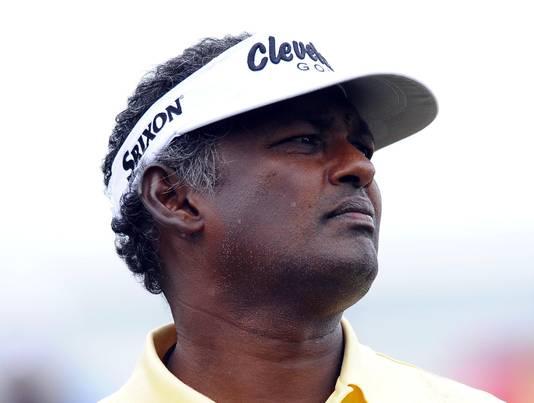PEBBLE BEACH, Calif. — More than a week has passed since the startling revelation that Vijay Singh took a substance prohibited under the PGA Tour Anti-Doping Program. Many Tour observers wonder how Singh, who has won 34 Tour events in a Hall of Fame career, could be competing this week at the AT&T Pebble Beach Pro-Am after such a turn of events.
The Singh case likely is the first time a player has openly admitted potentially violating the Tour’s Anti-Doping Program. It certainly is the first time the Tour has had to deal with such a public admission by a prominent player. The Anti-Doping Program, in force since 2008, includes policies and procedures for Tour officials to follow and avoid any rush to judgment.
GOLFWEEK: Complete coverage[1]
Those procedures generally are outlined in the program beginning with a positive test. In Singh’s case, no test was even administered. It stems from a Feb. 4 Sports Illustrated article that discloses Singh had used deer-antler spray, which contains Insulin-like Growth Factor-1, known as IGF-1, which is banned by the PGA Tour and many other sports. The spray is produced by Sports with Alternatives to Steroids, a two-man company in Birmingham, Ala.
The day after the disclosure, Singh issued a statement in which he admitted using the prohibited spray, potentially streamlining any discipline.
“While I have used deer-antler spray, at no time was I aware that it may contain a substance that is banned under the PGA Tour Anti-Doping Policy,” Singh, who turns 50 on Feb. 22, said in the statement. “In fact, when I first received the product, I reviewed the list of ingredients and did not see any prohibited substances. I am absolutely shocked that deer-antler spray may contain a banned substance and am angry that I have put myself in this position. I have been in contact with the PGA Tour and am cooperating fully with their review of this matter. I will not be commenting further at this time.”
Under the program, an admission would be similar to a positive test result, but did Singh actually admit to a violation?
Singh clearly acknowledged, in the Sports Illustrated article and in his statement, that he used the deer-antler spray, but he stopped short in the first sentence of his statement of suggesting that the deer-antler spray might contain IGF-1, a hormone.
Unlike a court of law in a criminal proceeding, Singh holds the burden of proof that the deer-antler spray does not contain the prohibited substance IGF-1.

Golfweek will share content with USA TODAY Sports.(Photo: Golfweek)
Singh and commissioner Tim Finchem reportedly met here to discuss the incident before the AT&T Pebble Beach National Pro-Am. Any meeting likely would be for Finchem to gather information and understand Singh’s position.
Singh would have many options in building a solid case, first for exoneration and second for mitigation if the deer-antler spray did, in fact, contain IGF-1. Among them:
1) Test the spray itself. According to PGA Tour sources, the deer-antler spray manufactured by SWATS has never been tested to determine whether the product contains the prohibited ingredient IGF-1.
Singh reportedly provided Finchem a sample of the product for testing. If the product is not found to contain IGF-1, then the violation of the Tour’s Anti-Doping Policy would go away because Singh would not have taken a prohibited substance. If the were found to contain IGF-1, Singh could argue certain mitigating circumstances for Finchem to review before any possible sanctions.
2) Even if the deer-antler spray does contain IGF-1, at least one expert said the banned substance could not enter Singh’s bloodstream and/or metabolize to provide any benefit.
Dr. Roberto Salvatori, a hormone expert at Johns Hopkins Hospital in Baltimore, said oral delivery of IGF-1 by a spray could not be effective and would be digested and destroyed by the enzymes in Singh’s saliva.
“IGF-1 is a rather large protein, and there is really no way it can be absorbed in the body by just applying on the tongue or even ingesting it,” Salvatori said on a recent Sirius/XM broadcast this month. “And the only way that IGF would be present there, could be effective, would be to inject it.”
Singh did not admit to injecting the spray, which was designed to be sprayed into the mouth.
“I believe it’s much ado about nothing,” Salvatori said.
3) Singh could maintain that he reviewed the product ingredients and found nothing among the contents to indicate that deer-antler spray contained IGF-1. Of course, ignorance is not an excuse for a violation under the Tour’s Anti-Doping Program – especially in this situation, after the PGA Tour notified players in a 2011 Green Sheet that this product was a concern.
4) Singh could argue that he didn’t receive proper notice that the deer-antler spray was a concern. But according to Tour sources, the Green Sheet is distributed in print and in players’ email, and because this is an argument for mitigation, it probably would not go far with Finchem.
5) Singh could use the commissioner’s own words, that no drug benefits golfers. At a news conference on July 1, 2009, at the AT&T National, Finchem talked about potential drug use in golf.
“In some sports, cycling, clearly there are drugs that can help you win,” Finchem said. “You can gain a real competitive advantage. I don’t think that’s true in golf, either, but it’s not really relevant. What’s relevant is, there’s a rule, players play by the rules, they believe in that, and in a way it’s helped us reaffirm that culture. So maybe that’s good.”
Procedurally, the PGA Tour must notify Singh in writing of a potential violation, and Singh would have seven days to provide a written explanation.
It is unclear how long Finchem would have to respond upon receiving a player’s written explanation. A chemical test of the deer-antler Spray is certain to take place, and Finchem could investigate any additional claims that Singh might raise in mitigation before the commissioner would make a ruling. After any finding by the Tour, Singh would have seven days to appeal any sanctions.
Any appeal would go before an arbitrator, and a hearing must occur within 45 days of the formation of an arbitration panel. After the hearing, the panel would have 15 days to render a written decision.
The math is a little fuzzy, but it’s clear that even if Singh were found to have violated the Tour’s Anti-Doping Policy and the case were to run its course, it could be late April or May before the case would be resolved.
Singh would not be prohibited from playing on the PGA Tour during the process.
Sanctions for a first-time offense could include a ban of up to one year on the PGA Tour and a fine of up to $500,000.
The PGA Tour acknowledges only one violation of its policy that covers performance-enhancing drugs. In 2009, Doug Barron was suspended for one year. Barron was taking Lyrica as a substitute for propranolol, a banned substance, and exogenous testosterone, which he received by an injection from a doctor. He had been prescribed propranolol since age 17. Barron had applied for two therapeutic exemptions for the medications, but the Tour denied the requests. Barron continued to take the drugs.
If Singh were to be exonerated under the Anti-Doping Program and IGF-1 is not an ingredient of the deer-antler spray, Finchem nonetheless could use his authority to impose a minor sanction and cite “conduct unbecoming a PGA Tour professional.”
The public nature of any violation and the negative media coverage could be enough for Finchem to discipline Singh.
